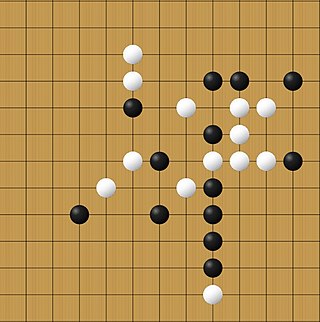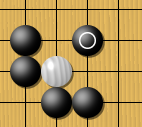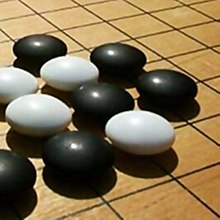
Sternhalma, commonly known as Chinese checkers or Chinese chequers, is a strategy board game of German origin that can be played by two, three, four, or six people, playing individually or with partners. The game is a modern and simplified variation of the game Halma. "Complexity: requires no counting or spelling; even young children can play."

Gomoku, also called Five in a Row, is an abstract strategy board game. It is traditionally played with Go pieces on a Go board. It is played using a 15×15 board while in the past a 19×19 board was standard. Because pieces are typically not moved or removed from the board, gomoku may also be played as a paper-and-pencil game. The game is known in several countries under different names.

Pente is an abstract strategy board game for two or more players, created in 1977 by Gary Gabrel. A member of the m,n,k game family, Pente stands out for its custodial capture mechanic, which allows players to "sandwich" pairs of stones and capture them by flanking them on either side. This changes the overall tactical assessments players face when compared to pure placement m,n,k games such as Gomoku.

The game of go has simple rules that can be learned very quickly but, as with chess and similar board games, complex strategies may be employed by experienced players.

Checkers, also known as draughts, is a group of strategy board games for two players which involve diagonal moves of uniform game pieces and mandatory captures by jumping over opponent pieces. Checkers is developed from alquerque. The term "checkers" derives from the checkered board which the game is played on, whereas "draughts" derives from the verb "to draw" or "to move".

Go is an abstract strategy board game for two players in which the aim is to surround more territory than the opponent. The game was invented in China more than 2,500 years ago and is believed to be the oldest board game continuously played to the present day. A 2016 survey by the International Go Federation's 75 member nations found that there are over 46 million people worldwide who know how to play Go and over 20 million current players, the majority of whom live in East Asia.

The rules of Go have seen some variation over time and from place to place. This article discusses those sets of rules broadly similar to the ones currently in use in East Asia. Even among these, there is a degree of variation.

Go proverbs are traditional proverbs relating to the game of Go, generally used to help one find good moves in various situations during a game. They are generalisations and thus a particular proverb will have specific situations where it is not applicable. Knowing when a proverb is inapplicable is part of the process of getting stronger as a Go player. Indeed, several proverbs contradict each other—however they agree in as much as they are advising the player to pay attention to the stated situation.

Computer Go is the field of artificial intelligence (AI) dedicated to creating a computer program that plays the traditional board game Go. The field is sharply divided into two eras. Before 2015, the programs of the era were weak. The best efforts of the 1980s and 1990s produced only AIs that could be defeated by beginners, and AIs of the early 2000s were intermediate level at best. Professionals could defeat these programs even given handicaps of 10+ stones in favor of the AI. Many of the algorithms such as alpha-beta minimax that performed well as AIs for checkers and chess fell apart on Go's 19x19 board, as there were too many branching possibilities to consider. Creation of a human professional quality program with the techniques and hardware of the time was out of reach. Some AI researchers speculated that the problem was unsolvable without creation of human-like AI.
Breakthrough is an abstract strategy board game invented by Dan Troyka in 2000 and made available as a Zillions of Games file (ZRF). It won the 2001 8x8 Game Design Competition, even though the game was originally played on a 7x7 board, as it is trivially extensible to larger board sizes.
Gonnect is a strategy board game for two players invented by João Pedro Neto in 2000. The game is played with standard Go equipment and basically uses the same rules as Go, however the goal of the game is to construct a group that connects any two opposite sides.

Life and death (死活) is a fundamental concept in the game of Go, where the status of a distinct group of stones is determined as either being "alive", where they may remain on the board indefinitely, or "dead", where the group will be lost as "captured". The basic idea can be summarized by:

English draughts or checkers, also called straight checkers or simply draughts, is a form of the strategy board game checkers. It is played on an 8×8 checkerboard with 12 pieces per side. The pieces move and capture diagonally forward, until they reach the opposite end of the board, when they are crowned and can thereafter move and capture both backward and forward.

Hasami shogi is a variant of shogi. The game has two main variants, and all Hasami variants, unlike other shogi variants, use only one type of piece, and the winning objective is not checkmate. One main variant involves capturing all but one of the opponent's men; the other involves building an unbroken vertical or horizontal chain of five-in-a-row.

There are many variations of the simple rules of Go. Some are ancient digressions, while other are modern deviations. They are often side events at tournaments, for example, the U.S. Go Congress holds a "Crazy Go" event every year.

Traditional Filipino games or indigenous games in the Philippines are games that have been played across multiple generations, usually using native materials or instruments. In the Philippines, due to limited resources for toys, children usually invent games without needing anything but players.There are different kinds of Philippine Traditional Games that are suited for kids, and the games also stand as one of the different culture and/or traditional games of the Philippines. These games are not only fun to play, but these games are also good for you. This is because different games require different skills. These games are also an important part in Filipino culture.

In the game of Go, shape describes the positional qualities of a group of stones. Descriptions of shapes in go revolve around how well a group creates or removes life and territory. Good shape can refer to the efficient use of stones in outlining territory, the strength of a group in a prospective fight, or making eye shapes so that a group may live. Bad shapes are inefficient in outlining territory and are heavy. Heavy groups cannot easily make eye shapes and are therefore good targets for attack. Understanding and recognizing the difference between good shape and bad is an essential step in becoming a stronger player.

Dots is an abstract strategy game, played by two or more people on a sheet of squared paper. The game is somewhat similar to Go, in that the goal is to "capture" enemy dots by surrounding them with a continuous line of one's own dots. Once an area containing enemy dots is surrounded, that area ceases to be playable.

Sygo is a two player abstract strategy game created in 2010 by Christian Freeling. It is a variant of Go. Sygo is played on a 19x19 grid of lines. It differs from Go in that captured stones change colors instead of being removed from the board, similar to Reversi/Othello. Additionally, each turn, players may either place a new stone, or else grow all of their existing groups of stones by placing a new stone adjacent to each group, similar to Symple, another of Christian Freeling's games. The goal of Sygo is to control the most territory on the board as determined by the number of a player's stones on the board as well as empty points surrounded by the players stones. The game ends either when one player resigns or both players pass on successive turns.











